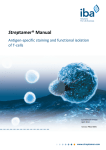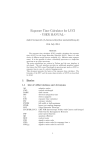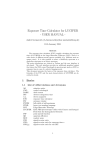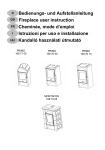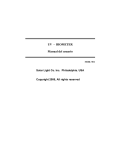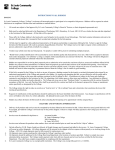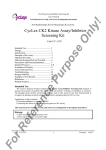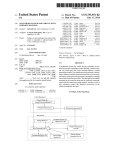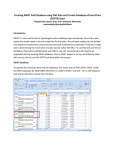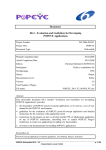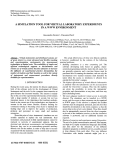Download Manual_MHC_Streptamer
Transcript
MHC I Streptamer® Manual I) Staining of antigen-specific CD8+ T cells with reversible MHC I Streptamers® and FACS isolation II) Isolation of antigen-specific CD8+ T cells with reversible MHC I Streps and Strep-Tactin® Magnetic Nanobeads Last date of revision July 2015 Version PR22-0012 For research use only Important licensing information The technologies Streptamer® and Strep-Tactin® are covered by intellectual property (IP) rights. On completion of the sale of a respective product IBA grants a Limited Use Label License to purchaser. IP rights and Limited Use Label Licenses are further identified at http://www.iba-go.com/patents.html or upon inquiry at [email protected] or at IBA GmbH, Rudolf-Wissell-Str. 28, 37079 Göttingen, Germany. By use of a respective product the purchaser accepts the terms and conditions of all applicable Limited Use Label Licenses. All products are for research use only. CAUTION: Not intended for human or animal diagnostic or therapeutic uses. Trademark information The owners of trademarks marked by “®” or “TM” are identified at http://www.iba-go.com/patents.html. Registered names, trademarks, etc. used in this document, even when not specifically marked as such, are not to be considered unprotected by law. 2 + MHC I Streptamer® Manual – Staining and isolation of antigen-specific CD8 T cells Content 1 The Streptamer® Principle 5 + 6 6 6 6 6 7 7 8 8 8 + 9 9 10 10 10 11 11 11 11 12 13 13 13 13 13 2 Reversible staining of antigen-specific CD8 T cells with MHC I Streptamers® and FACS isolation 2.1 Introduction: cell staining and removal of staining reagents 2.2 Required reagents and materials ® 2.2.1 MHC I-Streps and Strep-Tactin PE or APC ® 2.2.2 Streptamer Solution Set and pre-separation filters ® 2.3 Use and storage of MHC I-Streps and fluorescent Strep-Tactin 2.4 Staining procedure 2.5 Titration (optional) 2.6 Dissociation of Streptamers® with D-Biotin 2.7 Short Protocol 3 Magnetic isolation of antigen-specific CD8 T cells with MHC I Streptamers® 3.1 The principle: magnetic isolation and removal of labeling reagents ® 3.2 Streptamer reagents and magnetic columns for cell isolation ® MHC I-Streps and Strep-Tactin Magnetic Nanobeads 3.2.1 ® 3.2.2 Streptamer Solution Set Standard for washing & dissociation 3.2.3 Magnetic columns and pre-separation filters 3.3 Use and storage of MHC I-Streps and magnetic beads 3.4 Experimental procedure 3.4.1 Preparation of cells and Streptamers® 3.4.2 Cell Labeling with Streptamers® 3.4.3 Magnetic separation with LS column ® 3.4.4 Optional: Magnetic separation with the AutoMACS separator 3.4.5 Dissociation of Streptamers® with D-Biotin 3.4.6 Staining of T cells with Streptamers® 3.4.7 Short Protocol 4 5 References Warranty 14 14 + MHC I Streptamer® Manual – Staining and isolation of antigen-specific CD8 T cells 3 4 + MHC I Streptamer® Manual – Staining and isolation of antigen-specific CD8 T cells 1 The Streptamer® Principle Strep-tag®, Strep-Tactin® and Streptamer® Strep-tags are short peptides with high binding selectivity for Strep-Tactin®, an engineered streptavidin. The binding affinity of e.g. Strep-tag II to Strep-Tactin® (kD = 1 µM) is nearly 100 times higher than to streptavidin. Strep-tags may be fused to recombinant proteins which allows efficient one-step purification of such fusion proteins on immobilized Strep-Tactin® under physiological conditions, thus preserving their bioactivity. As the Strep-tag binds to the biotin binding pocket of Strep-Tactin®, purified proteins may be mildly eluted from the column by the addition of minute amounts of biotin. Further information is available at www.strep-tag.com. A special application of the Strep-tag®:Strep-Tactin® technology is the oligomerization of MHC I-Strep-tag® fusion proteins (MHC I-Strep proteins) on Strep-Tactin®. Multimers of MHC I-Streps complexed with either fluorescently or magnetically labeled Strep-Tactin®, so-called Streptamers, are used for efficient staining or isolation of antigen-specific T cells. After separation of the labeled T cells from non-labeled cells by flow-cytometric or magnetic cell isolation, the Streptamers are efficiently disrupted on the cell by addition of biotin. Subsequently, the dissociation and removal of the Strep-Tactin® backbone leaves monomeric MHC I-Strep proteins on the surface of the T cell. As the interaction of monovalent MHC I:T cell receptor is weak, MHC I-Strep proteins spontaneously dissociate from the T cell receptor and may be removed from the T cells simply by washing. Keeping cells at cooled conditions as well as performing the rapid and complete removal of the Streptamers® from the T cells assures the isolation of fully functional, non-induced T cells. Further information is available at www.streptamer.com. + MHC I Streptamer® Manual – Staining and isolation of antigen-specific CD8 T cells 5 2 Reversible staining of antigen-specific CD8+ T cells with MHC I Streptamers® and FACS isolation 2.1 Introduction: cell staining and removal of staining reagents Scheme of a fluorescent Streptamer® labeled T cell and subsequent biotin induced removal of the Streptamers® to yield a functional, non-induced antigen specific T cell preparation. 2.2 Required reagents and materials 2.2.1 MHC I-Streps and Strep-Tactin® PE or APC Cat.no 6-7XXX-005 6-5000-005 6-5010-005 Product Name MHC I-Strep Strep-Tactin® PE for MHC I Streptamers® Strep-Tactin® APC for MHC I Streptamers® Staining of 2.5x108 cells 2.5x108 cells 2.5x108 cells Size 0.2 ml 0.25 ml 0.25 ml 2.2.2 Streptamer® Solution Set and pre-separation filters Cat.no. Product Name Content 6-5603-005 Streptamer® Solution Set Standard Buffer IS, D-Biotin The Streptamer® Solution Set Standard contains 50 ml Buffer IS as 10x concentrate for washing, and 1 ml of a D-Biotin stock solution (100 mM) for dissociation of the Streptamers® from the isolated cells. Buffer IS has to be diluted with 9 volumes of water prior to use. We recommend to add EDTA at a final concentration of 1 mM. Degas buffer before use. The 100 mM Biotin stock solution has to be diluted with 99 volumes of Buffer IS prior to use (Biotin working solution is 1 mM; see 2.6.). Pre-separation filters (IBA GmbH, cat.-no.: 6-5601-010) are recommended for removal of cell clumps. 6 + MHC I Streptamer® Manual – Staining and isolation of antigen-specific CD8 T cells 2.3 Use and storage of MHC I-Streps and fluorescent Strep-Tactin® MHC I-Streps are shipped on dry ice and then stored at -80°C until use. After initial thawing prepare aliquots for long-term storage at -80°C. Aliqouts for immediate use should be kept permanently on ice. Aliquotation is mandatory to avoid freeze thaw cycles which denature the MHC I-Streps. Strep-Tactin® PE or APC for MHC I Streptamers® is shipped on blue ice and stored at 4°C. 2.4 Staining procedure The procedure is optimized for staining of antigen-specific CD8+ T cells from fresh or frozen peripheral blood mononuclear cells (PBMCs). When working with anti-coagulated peripheral blood or buffy coats, PBMCs should first be isolated by density gradient centrifugation and separated from platelets. Please adjust cell density to 107 cells / 100 µl before starting the protocol. Important: All steps have to be performed at 4°C! Please make sure that all your reagents and the cells have reached the temperature before starting the protocol. Protect labeled cells and fluorochrome reagents from light by incubating in the dark. Protocol for staining of ca. 5x106 cells (1 test): 1. Prepare ca. 3 ml Buffer IS from 10 x stock. 2. Incubate 5 µl Strep-Tactin®-PE or APC and 4 µl MHC I-Strep in a final volume of 50 µl Buffer IS for 45 minutes. 3. Add the pre-incubated Streptamers® (complex from Strep-Tactin®-PE (or APC) and MHC I-Strep, step 2) to the cell pellet. 4. Incubate for 45 minutes. 5. Wash cells twice with 200 µl Buffer IS. 6. Cells are ready for FACS-analysis or FACS-sorting. Dead cell exclusion is strongly recommended (e.g. propidium iodide, 7-AAD, etc.) + MHC I Streptamer® Manual – Staining and isolation of antigen-specific CD8 T cells 7 2.5 Titration (optional) If the staining protocol is not suitable for your application, a titration of the Streptamers® should be performed. Our recommendation for the titration is: Keep the cell concentration of 107 cells / 100 µl constant and increase the amount of Streptamers® stepwise (2-, 3- and 4-fold). Add the following volumes of pre-incubated (45 min) Streptamers® to your cell pellet: • 2-fold increase ( 8 µl MHC I-Strep + 10 µl Strep-Tactin® PE in 100 µl buffer IS) • 3-fold increase (12 µl MHC I-Strep + 15 µl Strep-Tactin® PE in 150 µl buffer IS) • 4-fold increase (16 µl MHC I-Strep + 20 µl Strep-Tactin® PE in 200 µl buffer IS) The assay can be conducted in a 96-well round bottom microplate. 2.6 Dissociation of Streptamers® with D-Biotin Important: All steps have to be performed at 4°C! Please make sure that all your reagents and the cells have reached the temperature before starting the protocol. 1. Collect cells by centrifugation. 2. Prepare ca. 1 ml Buffer IS containing 1 mM D-Biotin (1 mM Biotin working solution). 3. Resuspend cells in 200 µl Biotin working solution and incubate for 10 minutes. 4. Collect cells by centrifugation. 5. Repeat step 3 and 4. 6. Wash cells 4 times with 200 µl Buffer IS. 7. Transfer cells into the appropriate buffer or medium for further applications. 2.7 Short Protocol Please request a copy of our Short Protocol PR38 for MHC I Streptamer® Staining at [email protected] or download it from www.streptamer.com 8 + MHC I Streptamer® Manual – Staining and isolation of antigen-specific CD8 T cells 3 Magnetic isolation of antigen-specific CD8+ T cells with MHC I Streptamers® 3.1 The principle: magnetic isolation and removal of labeling reagents CD8+ T cells are labeled according to their antigen specificity with Strep-Tactin® Magnetic Nanobeads coupled to the specific MHC I-Strep. Labeled cells are separated from other cells by a magnetic field and retained target cells are eluted after removal of the magnet. All Streptamer® reagents are then released from the target cells by the addition of biotin (vitamin H) to yield a functional, non-induced antigen specific CD8+ T cell preparation. Example: Isolation of CMV-antigen specific T cells Isolation of human antigen specific T cells from PBMC with MHC I Streptamers®. Antigen-specific T cells were positive-selected with Strep-Tactin® Magnetic Nanobeads for MHC I Streptamers®, which were coupled to MHC I-Strep HLA-A*0201, CMV pp65495-503. Magnetically labeled cells were isolated on a MACS column. Thereafter, the Streptamer® reagents were removed from the target cells with 1 mM D-Biotin and cells were analyzed by flow cytometry. Before sort the antigen-specific T cells represented only 0.079 % of the total cell population. After sort an enormous enrichment by a factor of 1.000 and a high purity of 82 % became evident. These two important aspects were achieved with positive selection in only one step! + MHC I Streptamer® Manual – Staining and isolation of antigen-specific CD8 T cells 9 3.2 Streptamer® reagents and magnetic columns for cell isolation 3.2.1 MHC I-Streps and Strep-Tactin® Magnetic Nanobeads Cat.no 6-7XXX-005 Product Name MHC I-Strep 6-5500-005 Strep-Tactin® Magnetic Nanobeads for MHC I Streptamers® Isolation from 5 x 108 cells human 2.5 x108 cells mouse Size 1 x 0.2 ml 1 x 108 cells 1 x 0.25 ml 3.2.2 Streptamer® Solution Set Standard for washing & dissociation Cat.no. 6-5603-005 Product Name ® Streptamer Solution Set Standard Content Buffer IS, D-Biotin The Streptamer® Solution Set Standard contains 50 ml Buffer IS as 10x concentrate for washing and 1 ml of a D-Biotin stock solution (100 mM) for dissociation of the Streptamers® from the isolated cells. Buffer IS has to be diluted with 9 volumes of water prior to use. We recommend to add EDTA at a final concentration of 1 mM. Degas buffer before use, as air bubbles may block the column. The 100 mM Biotin stock solution has to be diluted with 99 volumes of Buffer IS prior to use (Biotin working solution is 1 mM). 10 + MHC I Streptamer® Manual – Staining and isolation of antigen-specific CD8 T cells 3.2.3 Magnetic columns and pre-separation filters For magnetic separation we recommend the MS or LS columns with the MACS® Manual Separators or the AutoMACS® from Miltenyi Biotech GmbH. For removal of cell clumps prior to column loading we recommend our pre-separation nylon filters (IBA GmbH, cat.no. 6-5601-010, includes 10 filters). 3.3 Use and storage of MHC I-Streps and magnetic beads MHC I-Streps are shipped on dry ice and then stored at -80°C until use. After initial thawing prepare aliquots for long-term storage at -80°C. Aliqouts for immediate use should be kept permanently on ice. Aliquotation is mandatory to avoid freeze thaw cycles which denature the MHC I-Streps. Strep-Tactin® Magnetic Nanobeads for MHC I Streptamers® are shipped on blue ice and stored at 4°C (do not freeze). 3.4 Experimental procedure The procedure is optimized for T cell isolation from 2 x107 cells. For cell numbers higher than 2 x107 we suggest a linear upscale of beads and MHC I-Streps. Some cells like monocytes or natural killer cells may be co-purified due to their ability to bind MHC I; they can be depleted by density gradient centrifugation or CD8+ pre-selection prior to T cell isolation. Important: All steps – the isolation of cells as well as the following dissociation of Streptamers® – have to be performed at 4°C. Please make sure that all your reagents and the cells have reached the temperature before starting the protocol. Avoid foaming, which interferes with proper bead retention on the magnet! 3.4.1 Preparation of cells and Streptamers® Human cells: The procedure is optimized to isolate antigen-specific CD8+ T cells from 2 x107 freshly isolated or frozen peripheral blood mononuclear cells (PBMCs). When working with anti-coagulated peripheral blood or buffy coat, PBMCs should be isolated by density gradient centrifugation first. Mouse cells: When working with cells from spleen or lymph node, be careful to resuspend cells completely. Other organ preparations may require protease digestion and/or gradient centrifugation. Mouse T cell separation protocol is established for 2 x 107 cells. Higher cell numbers require larger amounts of beads and MHC I-Streps. + MHC I Streptamer® Manual – Staining and isolation of antigen-specific CD8 T cells 11 Cell preparation (step 1-2): 1. Collect prepared cells and resuspend in 10 ml Buffer IS. 2. Pass cells through a nylon filter tube to remove cell clumps, which may clog the columns, and place cells on ice. MHC I Streptamer® preparation for human cells (step 3): 3. Incubate 50 µl Strep-Tactin® Magnetic Nanobeads, 8 µl MHC I-Strep, and 90 µl Buffer IS at least 45 minutes at 4°C (or overnight). 4. Proceed to 3.4.2 MHC I Streptamer® preparation for mouse cells (step 3): 3. Incubate 50 µl Strep-Tactin® Magnetic Nanobeads, 16 µl MHC I-Strep and 80 µl Buffer IS at least 45 minutes at 4°C (or overnight). 4. Proceed to 3.4.2 3.4.2 Cell Labeling with Streptamers® Purification of Streptamers®: removal of unbound MHC I-Strep (step 1-4): 1. Place MS column in the magnetic field and prepare column by rinsing with 2 ml Buffer IS. 2. Add 1 ml Buffer IS to Streptamers® (from 3.4.1 step 3, human or mouse) and load on MS column. 3. Wash MS column while in magnetic field with 2 ml Buffer IS to remove unbound MHC I-Streps. 4. Add 250 µl Buffer IS to MS column and elute retained Streptamers® (beads with bound MHC I-Streps) outside the magnetic field into a fresh vial; firmly flush out the purified Streptamers® using the plunger supplied with the column. Cell Labeling with purified Streptamers® (step 5-7): 5. Centrifuge cell suspension (300 x g) and resuspend the cells in 250 µl purified Streptamers® from 3.4.2 step 4. Incubate 45 minutes on ice. 6. Add 1.5 ml Buffer IS, centrifuge cell and Streptamer® mixture and carefully wash with 2 ml Buffer IS to eliminate unbound magnetic beads, which may trap cells on the column unspecifically. 7. Resuspend cells in 2 ml Buffer IS. Proceed to 3.4.3. or 3.4.4. 12 + MHC I Streptamer® Manual – Staining and isolation of antigen-specific CD8 T cells 3.4.3 Magnetic separation with LS column 8. Place LS column in the magnetic field and prepare column by rinsing with 3 ml Buffer IS. 9. Apply cell suspension (3.4.2 step 7) onto the column. Allow unlabeled cells to pass through. 10. Wash column with 3 x 3 ml Buffer IS, adding buffer each time once the column reservoir is empty. 11. Remove column from magnetic field, add 5 ml Buffer IS and flush out labeled cells (positive fraction) into a fresh vial by firmly applying the plunger supplied with the column. To increase purity, the magnetically labeled fraction can be passed over a new MS column (for up to 107 labeled cells) or LS column (for up to 108 labeled cells). 3.4.4 Optional: Magnetic separation with the AutoMACS® separator For detailed instructions on how to use the AutoMACS® please refer to the corresponding user manual. Choose program “PosseId” and collect positive cell fraction. 3.4.5 Dissociation of Streptamers® with D-Biotin 12. Centrifuge eluted cells (positive fraction), resuspend in 2 ml Buffer IS containing 1 mM D-Biotin and incubate for 10 minutes. 13. Repeat step 12. 14. Wash cells 3 times with 5 ml Buffer IS. 3.4.6 Staining of T cells with Streptamers® Antigen-specific cells can be visualized by utilizing the same MHC I-Strep which was used for magnetic isolation in combination with Strep-Tactin®-PE or APC. Proceed as described under 2.4. When a combinatorial staining with antibodies (especially anti-CD3 or anti-CD8 mAbs) is desired, add the respective antibodies only for the last 20 min of the staining protocol (2.4.; in total 45min) to avoid interference with the Streptamers®. A live/dead discrimination is suggested. 3.4.7 Short Protocol Please request a copy of our Short Protocol PR36 (Human) or PR37 (Mouse) for MHC I Streptamer® Isolation at [email protected] or download it from http://www.iba-lifesciences.com/technical-support.html + MHC I Streptamer® Manual – Staining and isolation of antigen-specific CD8 T cells 13 4 References Knabel, M., Franz, T.J., Schiemann, M., Wulf, A., Villmow, B., Schmidt., B., Bernhard, H., Wagner, H. and Busch, D. (2002) Reversible MHC multimer staining for functional isolation of T cell populations and effective adoptive transfer. Nature Medicine 8 (6), 631-637. Neudorfer, J., Schmidt, B., Huster, K.M., Anderl, F., Schiemann, M., Holzapfel, G., Schmidt, T., Germeroth, L., Wagner, H., Peschel, C., Busch, D. and Bernhard, H. (2007) Reversible HLA multimers (Streptamer) for the isolation of human cytotoxic T lymphocytes functionally active against tumor- and virus-derived antigens. JIM 320, 119-131. Wang, X., Simeoni, L., Lindquist, J.A., Saez-Rodriguez, J., Ambach, A., Gilles, E.D., Kliche, S. and Schraven, B. (2008) Dynamics of proximal signaling events after TCR/CD8-mediated induction of proliferation or apoptosis in mature CD8+ T cells. J. Immunology 180, 67046712. Yao, J., Bechter, C., Wiesneth, M., Härter, G., Götz, M., Germeroth, L., Guillaume, P., Hasan, F., von Harsdorf, S., Mertens, T., Michel, D., Döhner, H., Bunjes, D., Schmitt, M. and Schmitt, A. (2008) Multimer staining of cytomegalovirus phosphoprotein 65-specific T cells for diagnosis and therapeutic purposes: A comparative study. CID 46, e96-105. For more references please visit www.streptamer.com 5 Warranty The product sold hereunder is warranted only to conform to the quantity and contents stated on the label at the time of delivery to the customer. There are no warranties, expressed or implied, that extend beyond the description on the label of the product. IBA’s sole liability is limited to either replacement of the products or refund of the purchase price. Iba GmbH is not liable for property damage, personal injury, or economic loss caused by the product. Please refer to www.iba-lifesciences.com/technical-support.html downloading this manual. 14 for + MHC I Streptamer® Manual – Staining and isolation of antigen-specific CD8 T cells IBA Headquarters IBA GmbH Rudolf-Wissell-Str. 28 37079 Goettingen Germany Tel: +49 (0) 551-50672-0 Fax: +49 (0) 551-50672-181 E-mail: [email protected] IBA US Distribution Center 1328 Ashby Road Olivette, MO 63132 USA Tel. 1-877-IBA-GmbH (1-877-422-4624) Fax 1-888-531-6813 E-mail: [email protected]
















